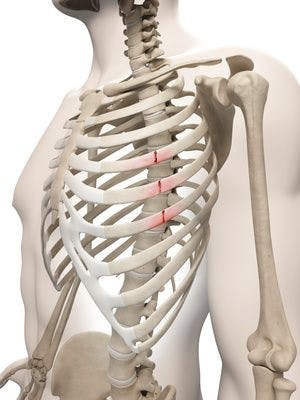It is estimated that about 300,000 people in the U.S. fracture their ribs each year. Broken ribs are usually a result of car accidents, falling on objects like a table or a ladder, or from sports contact injuries. In frailer populations, prolonged and intense coughing, osteoporosis or cancer can cause rib fractures.
Ribs are an important protectant of the chest cavity as they prevent trauma and injury to sensitive organs underneath. Rib fractures typically happen in the seventh and tenth ribs, while the first rib is protected by the collarbone. A fracture in a lower rib can cause injury to the diaphragm, causing a diaphragmatic hernia. Although painful, most simple rib fractures do not require surgery but instead time, rest and physical therapy can help with healing and maintaining range of motion.
The following describes symptoms we see and treatments we employ at Stride Strong’s Portland physical therapy clinics.
Signs and Symptoms of Broken Ribs

The biggest symptom of a broken rib is pain with breathing, which then causes the patient to breathe with shallow breaths. This is not conducive to proper gas exchange so the first intervention is to encourage deep breathing. Complications from shallow or inadequate breathing can include pneumonia, infection, collapsed lungs, and feeling faint. The patient can be given an incentive spirometer to encourage this: the patient’s breaths are measured while breathing through a connecting tube on a portable device.
If the patient hears a grating sound with breathing or movement, they must seek medical attention. This could be a potentially fatal condition where a portion of the chest wall moves separately than the rest of the chest and lungs – something that may happen if the patient has multiple breaks in adjacent ribs and back.
One of the other symptoms felt after a fracture is rib pain with movement. Coughing, pressure from lying on something, or twisting and bending over maneuvers can cause a lot of pain.
Broken Rib Physical Therapy Treatment
Initial Phase – immediately after diagnosis or injury
It is important to rest the ribs and modify your activity level so you do not place undue stress on the ribs. This may cause re-fracture, or worse, nonunion of the bones. If the rib fracture is high, you may need to hold your arm in a sling to avoid strain and pulling on the ribcage.
Latent phase – when pain is diminished and an X-Ray shows rehealing of the bone
Make sure to return to activity gradually for soft tissue and bony tissue to adapt to the strains of your sport. Focus at this stage should be on strengthening supporting muscles of the arm and torso, to prevent further strain on the newly-healed rib bone. For e.g. bicep strengthening through bicep curls can take some weight and pressure of your ribs when performing certain activities like throwing or swinging a racket. Core exercises shown by a physical therapist can help gradually strengthen your back and abdominal muscles to strengthen the torso, especially needed on contact sports.
Gentle stretching to the shoulder and trunk can help expand your chest cavity and may make breathing and moving easier. Stretching may also alleviate pain that is referred to the back or shoulders from the rib fracture, or pain from wearing an arm sling.
For patients who are frail and elderly, physical therapy can help the patient walk and normalize some function with a rib fracture. A physical therapist can train the patient to transfer between bed and chairs safely, while observing precautions that make the rib pain worse. A PT can also help with managing comorbidities like osteoporosis, diabetes, that may have indirectly caused the rib fracture in the first place via a fall or accident. To counteract the frailty, strengthening and balance exercises can be prescribed in physical therapy so re-injury does not occur.
Fractures of bones take at least six weeks to repair themselves, so exercise patience. Pain modulation is important for comfort, and your physical therapist can choose to do TENS electric stimulation to help modulate the pain non-narcotically. Consult with your physician if you wish to have prescribed medications for the broken rib pain.
Call today to schedule an appointment at one of our convenient Portland locations in Beaverton or Hillsboro and get your rib injury treated ASAP!
Not local? No worries! Click here to learn about our Telehealth Physical Therapy.

